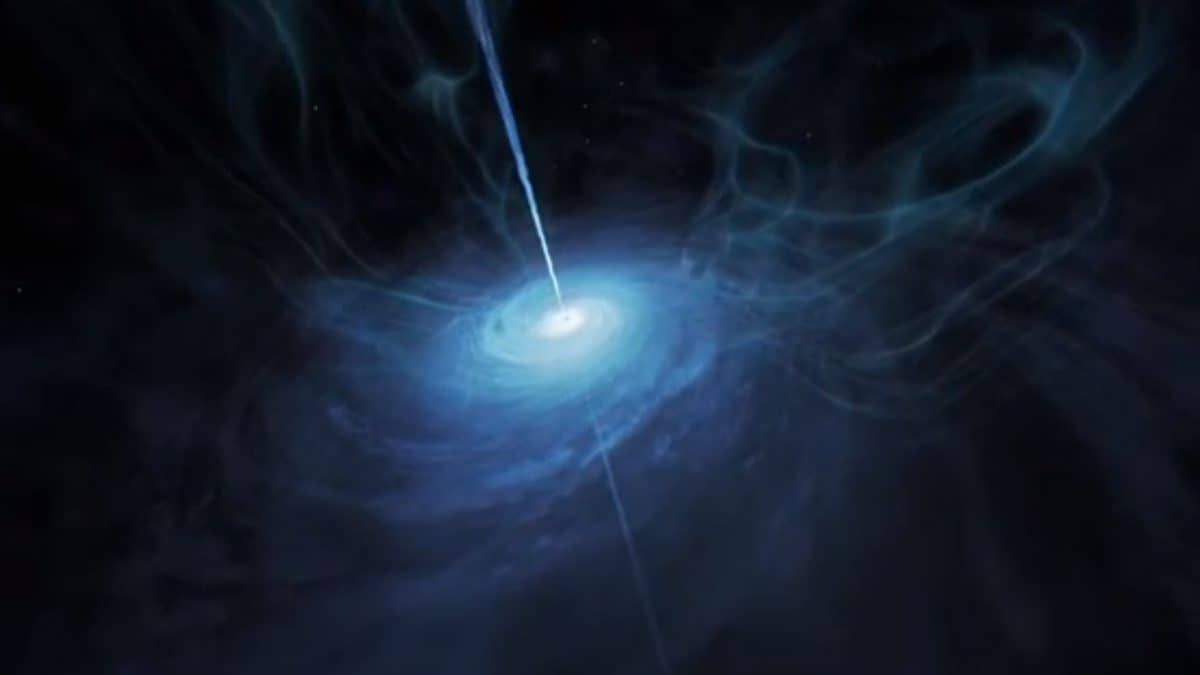
Light from the the brightest object ever discovered – dating back almost to the beginning of time – has reached Earth
The distant quasar – jets of energy powered by supermassive black holes – has the combined brilliance of about 600 trillion Suns, say astronomers.
It began its journey almost 12.8 billion years ago – soon after the Big Bang created the universe – nearly eight billion years before our solar system had even formed.
The US team say it has enabled us to “sample light emitted from the dawn of time.”
By chance a galaxy in the foreground acted as a gravitational lens – which magnified the ancient quasar.
This is a natural phenomenon in which the galaxies closer to Earth bend the light emitting from more distant ones.
Study leader Professor Xiaohui Fan, of Arizona University, said: “If it weren’t for this makeshift cosmic telescope the quasar’s light would appear about 50 times dimmer.
“This discovery demonstrates strongly gravitationally lensed quasars do exist despite the fact we’ve been looking for over 20 years and not found any others this far back in time.”
Quasars are found at the centre of galaxies – powered by supermassive black holes.
They are the brightest objects in the universe – outshining even the hottest burning stars.
The quasar, named J0439+1634, is believed to be fuelled by a supermassive black hole at the heart of a young forming galaxy.
Before the cosmos reached its billionth birthday some of the very first cosmic light set off through the expanding universe.
One particular beam – from J0439+1634 – luckily passed near an intervening galaxy whose gravity bent and magnified it.
This refocused it in our direction – allowing the twin Gemini telescopes in Hawaii and Chile to probe the quasar in great detail.
Dissecting a significant swath of the infrared part of the light’s spectrum revealed the tell-tale signature of magnesium.
This is critical for determining how far back in time we are looking. The observations also led to a determination of the mass of the black hole powering the quasar.
Combining these with data from multiple observatories around the world – and the Hubble Space Telescope, and other observatories around the world – painted a complete picture.
It showed the quasar is located extremely far back in time and space – when the very first light emerged from the Big Bang.
Team member Dr Jinyi Yang, also of the University of Arizona, said: “This is one of the first sources to shine as the Universe emerged from the cosmic dark ages.
“Prior to this, no stars, quasars, or galaxies had been formed, until objects like this appeared like candles in the dark.”
The foreground galaxy that enhances our view of the quasar is especially dim, which is extremely fortuitous.
Prof Fan said: “If this galaxy were much brighter, we wouldn’t have been able to differentiate it from the quasar.
“We don’t expect to find many quasars brighter than this one in the whole observable universe.”
The mass of the quasar’s supermassive black hole was calculated at 700 million times that of the Sun.
This is most likely surrounded by a sizable flattened disk of dust and gas. This matter – known as an accretion disk – most likely continually spirals inward to feed the black hole powerhouse.
Observations at submillimetre wavelengths with the James Clerk Maxwell Telescope on Maunakea, Hawaii, suggest that the black hole is not only accreting gas but may be triggering star birth at a prodigious rate.
This appears to be up to 10,000 stars per year; by comparison, our Milky Way Galaxy makes one star per year.
Because of their brightness and distance, quasars provide a unique glimpse into the conditions in the early Universe.
The foreground galaxy which bent the quasar’s light is about half that distance away, at a mere 6 billion light years from us.
The quasar is ripe for future scrutiny. Astronomers also plan to use the Atacama Large Millimeter/submillimeter Array, and eventually NASA’s James Webb Space Telescope, to look within 150 light-years of the black hole.
This will directly detect the influence of the gravity from black hole on gas motion and star formation in its vicinity.
Any future discoveries of very distant quasars like J0439+1634 will continue to teach astronomers about the chemical environment and the growth of massive black holes in our early Universe.